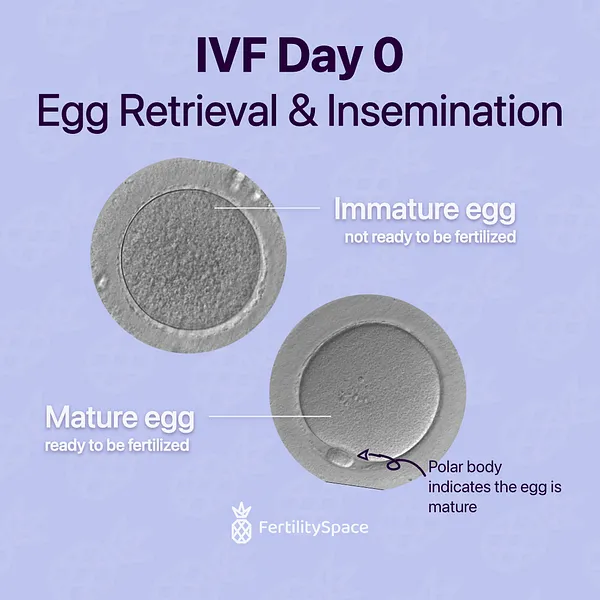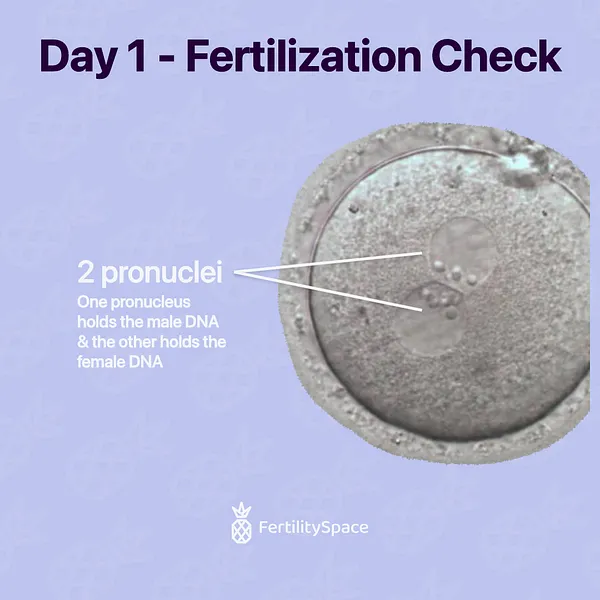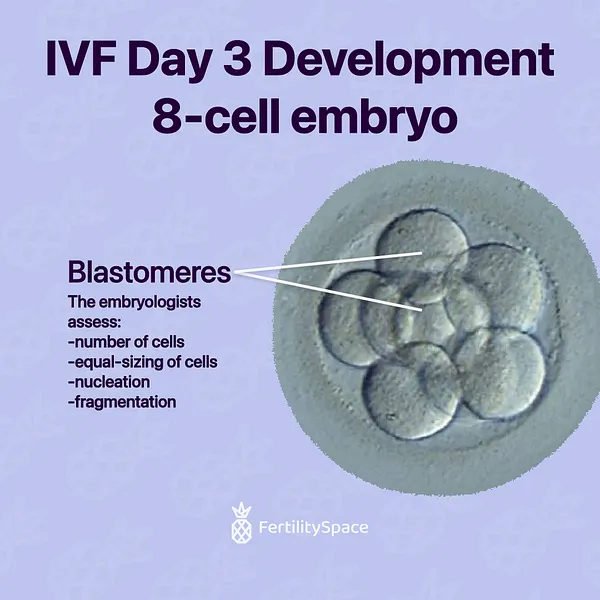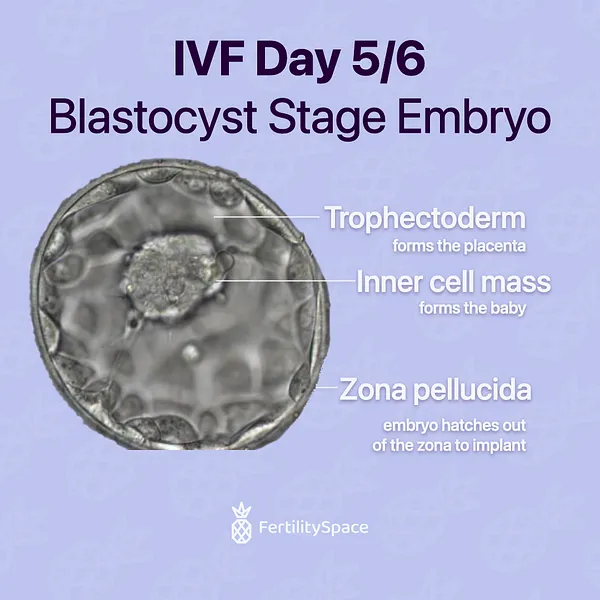Guides
IVF Cycle Embryo Development Day-by-Day - What are your embryos up to?

Waiting after your egg retrieval for fertilization & embryo development results can be stressful. Image of clock lying on a surface which is half baby blue and half baby pink.
After your egg retrieval is complete, you'll be spending the next week waiting for updates from the embryology lab at your fertility clinic on how your IVF cycle is going.
During the start of an IVF cycle leading up to the egg retrieval, it can feel like a whirlwind of scheduling, injections, ultrasound & bloodwork appointments, and countless phone calls.
And then all of a sudden after the egg retrieval, your part is done. And there's nothing to do but wait for updates on how the cycle went.
It can be a little nerve-wracking waiting for news about your embryos if you feel like you don't have any insight into the process.
What happened to my eggs after the retrieval? How many eggs did I get? Did they fertilize? Did any embryos develop? How many embryos will I end up with?
Here's the BTS (behind the scenes 😉) of the embryology lab for what stage your embryos should relatively be at for each day of development.
During the start of an IVF cycle leading up to the egg retrieval, it can feel like a whirlwind of scheduling, injections, ultrasound & bloodwork appointments, and countless phone calls.
And then all of a sudden after the egg retrieval, your part is done. And there's nothing to do but wait for updates on how the cycle went.
It can be a little nerve-wracking waiting for news about your embryos if you feel like you don't have any insight into the process.
What happened to my eggs after the retrieval? How many eggs did I get? Did they fertilize? Did any embryos develop? How many embryos will I end up with?
Here's the BTS (behind the scenes 😉) of the embryology lab for what stage your embryos should relatively be at for each day of development.
Do you like your fertility clinic? 💌 🙏 Review your fertility doctor on our site! Other women need your opinion to help them choose a great fertility provider!
Embryo Development Timeline for IVF
Day 0️⃣ IVF
In the embryology lab we start at Day 0, which makes it easier to count the days of embryo development.
Day 0 is the day of the:
👉egg retrieval
👉semen collection (or thawing of frozen sperm)
👉semen collection (or thawing of frozen sperm)
👉egg fertilization attempt (ICSI or conventional IVF)
After the egg retrieval, the first thing you'll be told is how many eggs were:
1️⃣retrieved
2️⃣mature (however, you won't learn this piece of info until Day 1)
📈According to the most recent IVF data from the CDC, 91.3% of egg retrievals were successful in recovering eggs.
Those are some good odds, however this rate lowers as a woman's age increases and a successful retrieval doesn't guarantee a successful outcome.
🔎 What is Egg Maturity in IVF?
Although you may retrieve a certain number of eggs, you might not be able to use them all for your IVF cycle.
It's important to know how many eggs were mature out of the ones you retrieved.
How can you tell the difference between mature and immature eggs?
🧬A mature egg has a polar body.
The polar body actually holds excess DNA that the egg extruded!
Human embryos have 46 chromosomes, 23 of these come from the egg and the other 23 come from the sperm.
An immature egg actually has all 46 chromosomes already. So after the egg extrudes half of its chromosomes as a polar body, it is now considered mature and the egg is ready for the sperm to provide the second half of the DNA needed to create an embryo.
🙅♀️An immature egg has not yet extruded a polar body, so will not fertilize in the majority of cases.
Patients with low egg maturity may do IVM-ICSI, in which any eggs that have matured by the next day can be inseminated.
There are some practices, such as Dominion Fertility in Arlington, VA that do inject immature eggs.
Dominion Fertility embryologist, Mark Henein, who routinely injects immature eggs by ICSI says that these eggs "can fertilize about 10% of the time but also have lower development".
How are the eggs fertilized in IVF?
After your egg retrieval, your eggs are counted, cleaned (if you're doing ICSI), and inseminated.
Sperm is collected or thawed and processed with centrifugation over gradients to sort the higher quality sperm from the sperm with less viability. There are two different methods that can be used to fertilize the eggs.
For ICSI, an embryologist will inject a single sperm into each egg using a very thin pipette.
For standard IVF, the eggs will be placed in a dish with the sperm so that a single sperm can hopefully reach an egg on its own and successfully fertilize it.
The eggs are stored overnight in an incubator with a specific gas mixture, temperature, & humidity that simulates the conditions inside the female reproductive tract.
The next day, an embryologist will check each egg for signs of successful fertilization! 🙌
Day 1️⃣ Fertilization
⏰Time to check for successful fertilization!
An embryologist usually checks the eggs for fertilization about 16-18 hours post-insemination.
You'll find out today how many eggs were:
An embryologist usually checks the eggs for fertilization about 16-18 hours post-insemination.
You'll find out today how many eggs were:
👉retrieved
👉mature
👉fertilized
Egg Maturity is only reported for ICSI cycles
Keep in mind that your team will only know how many eggs were mature in an IVF cycle if you do ICSI. Why?
When eggs are retrieved, they are covered in a gelatinous coating of cells called cumulus cells.
🧼Eggs are 'cleaned' for ICSI, also know as denuding or stripping.
During this process, the cumulus cells are removed from the surface of each egg.
This is done so that the embryologist can identify which eggs are mature and can be injected with a sperm.
🧫In standard IVF, where the sperm are placed with the eggs in a dish overnight, they don't clean the eggs until the next day when they check fo fertilization. So they won't know how many eggs were mature prior to checking for fertilization.
✅ Fertilization
🤷♀️How do they know which of your eggs fertilized?
The embryologists are looking for ‘2PN 2PB’, which is short for '2 pronuclei and 2 polar bodies'.
The primary focus is on the number of pronuclei (PN) they see under the microscope.
The primary focus is on the number of pronuclei (PN) they see under the microscope.
👍2PN = normal fertilization
🔬The two pronuclei (2PN) look like two bubbles floating on top of the egg with little granules inside of each. This is the DNA!
📸You can see the pronuclei (2PN) showing successful fertilization in the above photo!
🎥If your clinic shares time-lapse footage of your embryos, you may see the two pronuclei pop out at the start of the time-lapse & then disappear back into the embryo before it starts dividing.
At any given stage of development, some embryos may not divide normally & arrest (stop developing) but others continue on!
In some cases, none of the embryos from a cycle will make it to the stage where they can be transferred or frozen.
📈Of women that successfully retrieve eggs, the CDC reported that 87.5% of cycles successfully continue on to an embryo transfer or freezing of embryos.
Day 3️⃣ of embryo development
Your embryos should have been dividing over the past couple of days and reached the ~8-cell stage by now, also known as the cleavage stage.
📐Each embryo is graded at this point to see whether they measure up to the typical embryo development timeline for a Day 3 embryo.
🤷♀️What makes a good Day 3 embryo?
Cleavage-stage embryos are checked for:
👉cell number
👉equal-sizing of cells
👉cell nuclei
👉cell fragmentation
✅An embryo with 6-10 equal-sized cells is considered to be right on track.
Two things you don't really want to see are high cell fragmentation and multi-nucleation.
Some patients do an embryo transfer on Day 3, however it’s not the most common time to transfer an embryo and is only suggested in certain cases.
👀What happens after Day 3?
⏩From this point, embryos continue dividing and compact into a bundle of cells, known as a morula before continuing on to the well-known blastocyst stage.
📆You most likely won't get your next update on your embryo's development until Day 5!
👀What happens after Day 3?
⏩From this point, embryos continue dividing and compact into a bundle of cells, known as a morula before continuing on to the well-known blastocyst stage.
📆You most likely won't get your next update on your embryo's development until Day 5!
💌 🙏 Review your fertility doctor on our site! Other women need your opinion to help them choose a great fertility provider!
Day 5️⃣ / 6️⃣ of embryo development
This is when you start to see embryos at the most well-known stage in IVF. The blastocyst stage.
Embryos often develop at different rates from one another. Some embryos reach the blastocyst stage by Day 5 while others take until Day to form.
Blastocysts are very easy to identify, as they have a very distinctive cell architecture to them.
They have an Inner Cell Mass, which are the cells that become the baby surrounded by Trophectoderm cells, which form the placenta upon implantation.
Inner Cell Mass ➡️ Baby 👶
Trophectoderm ➡️ Placenta
Blastocysts are very easy to identify, as they have a very distinctive cell architecture to them.
They have an Inner Cell Mass, which are the cells that become the baby surrounded by Trophectoderm cells, which form the placenta upon implantation.
Inner Cell Mass ➡️ Baby 👶
Trophectoderm ➡️ Placenta
🧬The trophectoderm is actually what is tested for Preimplantation Genetic Testing.
So if you're doing genetic testing such as PGT-A or PGT-M or PGT-SR if you have a balanced translocation for example, it might be handy to know that the baby's cells are not tested directly. Just a few of the embryo's pre-placental cells are tested.
📈Transfer of a PGT-A normal embryo has a 60% chance of live birth on average.
If you want to learn more about PGT-A, check out our guide to preimplantation genetic testing where we talk about what PGT-A results can & cannot tell you, what happens to your embryos, the cost, test accuracy, and more.
🥇Blastocyst Embryo Grading Scale
At this point, the embryos are graded again. This is the stage where you start to see a grading system such as 4AB, 5AA, 4BC, etc.
🤔What’s a Good Grade for a Blastocyst?
The embryologists use criteria to assess which embryos have developed optimally.
The embryo is graded on each of these three factors:
- the embryo expansion
- the inner cell mass
- the trophectoderm
A scale is then used to give a grade for each of the above factors.
Not all clinics use the same blastocyst grading scale but the common scale is:
👉expansion graded 1-6 (6 = optimal)
👉inner cell mass graded A-C (A = optimal)
👉trophectoderm graded A-C (A = optimal)
For example, an embryo with a good grade would be a 5AA embryo.
An embryo with a poor grade would be 2BC, which means it has an expansion of '2', an inner cell mass graded 'B', and a trophectoderm graded 'C'.
🤷♀️Does embryo grade affect IVF success rates?
While studies have shown that embryos with a poor grade are associated with lower pregnancy rates, as they are often chromosomally abnormal, it doesn't mean that all poorly graded embryos result in a failed transfer!
A 2018 study looking at single blastocyst frozen embryo transfer cycles found a significant difference in live birth rate depending on embryo grade.
📈Blastocyst grade group & Live birth rate
Good-quality ➡️ 67.8%
Average-quality ➡️ 53.4%
Poor-quality ➡️ 29.5%
Additionally, the rate at which the embryo developed had a significant effect on live birth rate.
Day 5 good-quality blastocysts (72.8%) vs Day 6 good-quality blastocyst (56.5%).
While studies have shown that there is an association between an embryo with a poor grade having lower pregnancy success rates, as they more often do not have the correct number of chromosomes, it doesn't mean that all poorly graded embryos result in a failed transfer!
Some embryos that develop slowly or have a poor grading are chromosomally normal and do result in a healthy baby.
PGT-A
One way you would have more information ahead of the transfer would be to test with PGT-A to see whether your embryos have the correct number of chromosomes needed for life.
PGT results will report whether an embryo is euploid or aneuploid.
👌euploid = correct number of chromosomes
🙅♀️aneuploid = incorrect number of chromosomes
This testing is optional and some patients just choose to transfer the best graded embryos they have without genetic testing.
Female age affects the likelihood of getting a normal embryo from your IVF cycle.
Older women have a higher incidence of chromosomal abnormalities in their embryos, while younger women tend to have a higher proportion of euploid embryos.
If you're wondering whether the added cost & time of testing your embryos is worth it, check out this recent study done assessing the cost benefits of doing PGT-A based on your age.
What happens once you have blastocysts on Day 5/6?
Depending on your family-building plans, your body, and your fertility doctor's recommendation, next steps might be:
⤴️Fresh embryo transfer
Some women do a fresh embryo transfer on Day 5 or 6 to attempt a pregnancy within the IVF cycle.
🧬Embryo Biopsy
Some patients may choose to first have their embryos tested by PGT and use the results to decide which embryo to transfer.
In this case, before scheduling a transfer cycle:
👉embryos are biopsied
👉biopsies are sent to a PGT lab
👉embryos are frozen to await results
❄️Embryo Freezing
Whether you're genetically testing or not, embryos can be frozen at this time and later thawed for a frozen embryo transfer cycle (FET).
A frozen embryo transfer is commonly done the very next month after the IVF cycle.
In some cases you may have to forgo a fresh transfer during your IVF cycle and do an FET cycle instead. This is done often for women who may have had ovarian hyperstimulation syndrome (OHSS) from their IVF cycle or for women who did PGT-A that need to wait for the test results.
Additionally, Henein says that an FET "is also done as a general practice for many clinics to allow the body to normalize from the stimulation protocol which usually results in better implantation".
Even if you do a fresh embryo transfer, you can still freeze any remaining embryos you have from your cycle.
This way, you hopefully won't have to do another egg retrieval if you need to try for a pregnancy again and can instead do an FET, which is much cheaper and requires less heavy duty medication than an IVF cycle.
We hope knowing what your embryos may be up to during this week helps while you wait for updates!
🙋♀️ Are you happy with your fertility doctor? REVIEW your fertility doctor anonymously to help others just getting started find the best fit. It only takes 5 minutes!



